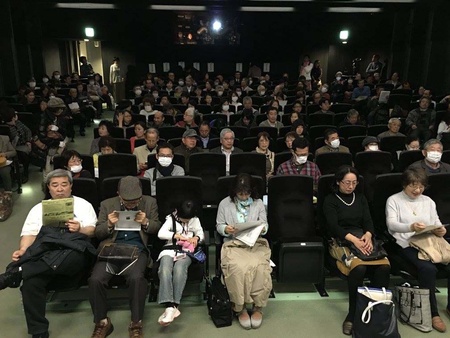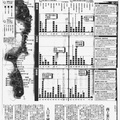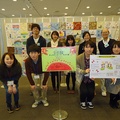On March 20, 2016, nine days after the fifth anniversary of the Great East Japan Earthquake, we, a group of volunteer citizens, held a screening of the documentary film "Tohoku's New Moon" produced by Linda Ohama in Sendai. The film was completed at the end of February. Linda came to Japan on March 7 with a Blu-ray containing the film. She chose Sendai as the location for the premiere.
At 9:00 a.m. on the day of the screening, as the doors to the screening venue, Sendai Mediatheque, were unlocked, dozens of people poured into the building and all headed for the theater. We were anxious to be ready to check in at 10:00 a.m. when the screening started, so we were in a hurry. After a brief meeting, it was just after 9:20 a.m. when everyone took their places. The corridors were already crowded with more than 100 people.
"Please wait in two rows." Miyata Tatsuo, the guide, kindly called out to the eager visitors several times, and the confusion was contained. Visitors entered the venue in an orderly fashion, holding the numbered tickets they had been given. The seats in the theater, which has a capacity of 180 people, filled up in no time.
Just before the screening started, the staff contacted me and said, "We refused entry because the theater was full. However, there is a customer who said, 'I want to see the movie that starts at 10 am no matter what.'" I asked that person to watch the second screening, but he did not understand. While I was at a loss as to what to do, the theater attendant informed me that there was "just one spare seat." There was even a moment when we asked that person to sit in the last seat.
At 9:50am, the host, Yuko Tachibana, declared the opening. Next, Executive Committee Chairman Tsuneaki Ohashi and Linda gave speeches. After Linda was presented with a bouquet of flowers by the Executive Committee to celebrate the completion of the film, a message was read out. The message was from Canadian Prime Minister Justin Trudeau. It was addressed to the visitors that day and the people in the disaster-stricken areas. It described what Linda has done for the disaster-stricken areas and that she was praying for their recovery on behalf of the Canadian people. We never expected to receive a message from the Prime Minister of Canada. We were surprised and very happy. No doubt the visitors felt the same way. All the Executive Committee members gained a new appreciation for Linda after receiving a message from the Prime Minister of a country.
10:00 AM. The lights in the theater are dimmed and the first screening begins. The film begins in the kitchen of the Ohashi home, where Linda provides a room free of charge when she comes to Sendai. Scenes of everyday life are followed by words written in calligraphy such as "Hometown," "Family," "History," "Memories," "Beauty," and "Love," and the scars of the earthquake disaster are overlaid on the voices reading these words. Just one minute into the film, sobs can be heard from the audience. It is easy to imagine that the terrifying experience is reliving it.
After the shocking footage of the tsunami engulfing the town, there is silence. In the silence, actress Kusakari Tamiyo's neat and warm narration tells us how Linda came to visit Tohoku. In contrast to the rough and tense scene that just preceded it, Kusakari's quiet and gentle way of speaking made my eyes water. This may be because I have seen Linda's back as she provided various forms of support for the disaster-stricken areas since immediately after the earthquake.
The film unfolds as the victims of the disaster from Iwate, Miyagi, and Fukushima talk about that day and what happened afterwards. A woman and her family narrowly escape death after being swept away by the tsunami. A man who makes a quick decision to pull his wife out, and both of them escape. A woman shows her former home, which was reduced to its foundations by the tsunami. A woman and her seven children live in fear of the effects of the nuclear accident. A man who lost his hometown in the nuclear accident. A man who tries to protect a traditional event that was on the verge of extinction due to the evacuation of residents. A man who moved from Shimane Prefecture to the disaster area to volunteer. A mayor who appeals for help from the world online. Mothers in Fukushima who want to protect their children from the nuclear accident but are conflicted in an atmosphere where they are hesitant to even say so. Many audience members are deeply moved by the circumstances of each of the characters. One middle-aged man told me that he cried throughout the entire screening. It is not hard to understand his feelings. Everyone has had similar experiences, to varying degrees.
Many people said, "After watching the movie, I felt as if a refreshing breeze was passing through my heart." This may be because the images shown in the last 20 minutes or so of the film show the people of Tohoku, who are not discouraged even in the midst of difficulties, but are cheerful and determined to live with their heads held high.
After the screening, Linda and I saw the audience off as they headed out the door. I could see tears in everyone's eyes. Some people even asked Linda for a handshake or hug. I could understand their feelings. The film beautifully represents the feelings of the victims.
In this way, we were able to screen "Tohoku Shingetsuki" four times on the day, and 461 people were able to see it. In addition, Blaise Plant, a member of the famous local music band Monkey Magic, and Martin Kuehnert, former general manager of the professional baseball team Rakuten Golden Eagles, also came to the screening, adding a touch of glamour to the event.
Thanks to everyone's support, the screening in Sendai was a success. However, the road to realizing the screening was not an easy one. In October 2013, I decided to hold an independent screening of Linda's film and started preparing. For two and a half years since that day, Mieko Sugimoto and I visited organizations, local governments, and influential people. We asked for their cooperation in holding the screening. However, time passed without any solid response. It was only in December of last year, when the film was about to be completed, that things got back on track. In the final stages, we were supported by volunteers who offered to help, and by citizens and media who were touched by Linda's thoughts. Without these people, I don't know if the screening would have been realized. I would like to express my sincere gratitude to everyone who was involved in holding the screening.
I have heard that the day when the film will be screened in Canada is not far off, and when it is, I hope that viewers will be able to see the people of Tohoku finding hope for the future and striving to live strong lives, even in the face of adversity.
Finally, we would like to express our sincere gratitude for the abundant support you have provided to the affected areas since immediately after the earthquake.
© 2016 Tsutomu Nambu










